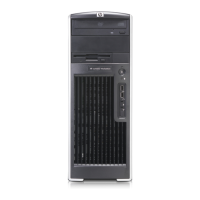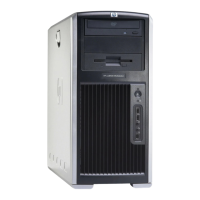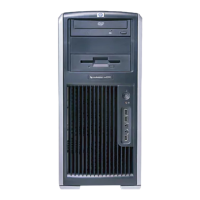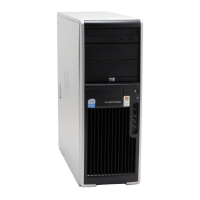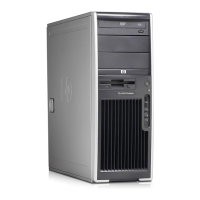Asset Tag
Repository for storing company-specific property asset numbers for easy tracking
Initially set equal to the system serial number
Stored in a protected section of non-volatile memory that can be accessed and modified with the
F10 Setup program
DIMM Serial Presence
Detect
Detects whether or not memory DIMMs are present and their type
Hard drive serial number,
model, and manufacturer
Hard drive manufacturer, model, and serial number is stored in the hard drive firmware and reported in
ROM-based F10 setup
System serial number,
model, & manufacturer
System serial number, model, & manufacturer stored in a non-volatile memory and can be retrieved with
management SW or viewed in ROM-based F10 setup
ROM revision levels
Identifies system ROM revision levels and reports in ROM-based F10 setup
Version is stored in an industry standard memory location (SMBIOS) so that management SW applications
can use and report this information
Memory Change Alert
(Requires HP Client
Manager Software)
Alerts management console if memory is removed or changed
Ownership Tag
A user-defined string stored in non-volatile memory that is displayed in the BIOS splash screen
Hard drive interface
Integrity Monitoring
(CRC Checking)
A feature of SATA and SCSI, Cyclic Redundancy Checking provides data transfer verification and proactive
notification of hard drive data transmission problems with recommendations for enhancing system
performance. It detects all the following errors' types:
single bit errors
double bit errors
an odd number of errors
error bursts up to 32-bits long
Drive Self Tests (DPS)
Drive Protection System (Adaptec and LSI SCSI controllers do not offer DPS)
A diagnostic hard drive self test. It scans critical physical components and every sector of the hard
drive for physical faults and then reports any faults to the user.
Running independently of the operating system, it can be accessed through the computer's setup
procedure. It produces an evaluation on whether the hard drive is the source of the problem and
needs to be replaced.
The system expands on the Self-Monitoring, Analysis, and Reporting Technology (SMART), a continuously
running systems diagnostic that alerts the user to certain types of failures
DPS Access through F10 Setup during Boot (F10 diagnostic access not available with SCSI drives)
SMART Technology
(Self-Monitoring, Analysis
and Reporting Technology)
Allows hard drives to monitor their own health and to raise flags if imminent failures were predicted
Predicts failures before they occur. Tracks fault prediction and failure indication parameters such as re-
allocated sector count, spin retry count, calibration retry count
By avoiding actual hard drive failures, SMART hard drives act as "insurance" against unplanned user
downtime and potential data loss from hard drive failure
SMART I – Drive Failure Prediction
SMART II – Off-Line Data Collection
SMART III – Off-Line Read Scanning with Defect Reallocation
QuickSpecs
HP xw6200 Workstation
Technical Specifications
DA - 11975 Worldwide — Version 46 — May 25, 2007
Page 28

